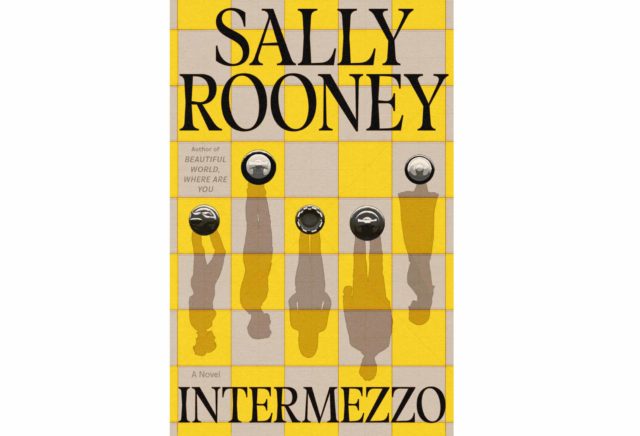This post was updated Sept. 25 at 11:04 p.m.
In a literary game of chess, Sally Rooney deftly achieves an expected checkmate, yet not without facing several stalemates in the process.
Hitting bookshelves Sept. 24, sad-girl lit darling Sally Rooney’s much-anticipated fourth novel “Intermezzo” follows the relationship between brothers Ivan and Peter while navigating the loss of their father and their tumultuous romances. Clocking in at nearly 500 pages, Rooney’s latest marks her densest work yet, not only in terms of page count but also in the exploration of themes both new and old, spanning the nature of love, the existence of God and, of course, Marxism.
Boldly departing from her usual female-centric narrative vectors, Rooney instead aims her shrewd looking glass at two male protagonists for the first time in “Intermezzo.” Peter, a 32-year-old human rights lawyer, is trying to juggle two precarious relationships in tandem with his drug addiction. Meanwhile, his awkward 22-year-old brother Ivan attempts to find solace in 36-year-old love interest Margaret after their father’s death and his downfall from competitive chess. This change makes for a refreshing and entrancing reading experience for Rooney groupies and newbies alike, especially given that the male psyche has really only been sliced open and dissected once before with the beloved Connell of 2018’s “Normal People.”
[Related: Book review: ‘The Honey Witch’ simply but sweetly depicts whimsical romance, enchanting imagery]
Not only does Rooney brave new waters in the camp of subjects but in that of themes as well. In past novels, the theme of grief and loss had been relatively untouched by Rooney’s perspicacious eye. In “Intermezzo,” she explores how grief both justifies and mars love in a satisfyingly back-and-forth way, perhaps evocative of an intense round of chess. If certain humanistic themes are lucky to receive examination by Rooney’s masterful understanding of interpersonal dynamics and psyches, then this is certainly one of them.
Rooney’s typical preoccupations invariably reveal themselves throughout the narrative. A self-proclaimed Marxist, Rooney has spent much of her bibliography writing characters dealing with the romantic implications of class disparities to great avail. In “Intermezzo,” class hierarchies divide Margaret from Ivan, Ivan from Peter and Peter from his lovers. Though perhaps slightly more underlying than past apparent cases, Rooney executes this subject once again with such a dexterous hand that it merely complements the other sociopolitical turmoil her characters go on to experience within the narrative. Furthermore, Rooney has found a new host for her consistent exploration of God’s existence. Ivan believes that God’s existence could lie within strategic and statistical beauty, while Margaret believes it could lie within morality – a comparison simultaneously expounding upon her failed marriage. The metaphor of chess as a divine presence is one of Rooney’s most poignant and lyrical, and it is evidently a reward of her thematic determination.
Never sitting in the bylines but instead orbiting in constant kinesis around Ivan and Peter are the female characters Rooney has already proven to write prodigiously. Romantically involved with Peter are Sylvia, a childhood-friend-turned-situationship recovering from a life-altering accident, and Naomi, an occasionally complex manic pixie dream girl. As Peter reckons with the tragic death of his father, readers expect his relationships with Sylvia and Naomi to channel different facets of this loss – Sylvia reflects Peter’s intellect and rationality, while Naomi reflects his hedonistic tendencies. In this, Rooney seems to become confused. Readers, following this pattern, will expect Sylvia and Naomi to have depth equal to each other when they certainly do not, with Sylvia herself coping with complex grief alongside Peter and Naomi simply being the subject of much sugar daddying.
Historically, Rooney has always positioned herself as not only an orchestrator of narrative but also an interlocutor with readers. In her debut novel “Conversations with Friends,” she communicated her now-characteristic sociopolitical languor through her protagonist’s maladies and sexual misfortunes. In “Normal People,” she amplified this voice organically and subtly, weaving it into conversational musings between protagonists Connell and Marianne, and, most recently in 2021’s “Beautiful World, Where are You,” it was at its most distilled – in emails between characters.
Yet in “Intermezzo,” Rooney enters a new stylistic gambit: a dual prose. While Ivan’s Proustian narration is crystalline and exact, Peter’s echoes that of Hemingway – staccato and blunt – yet increasingly poised as the narrative progresses. Rooney’s ruminations emerge from both Ivan’s charmingly naive inner monologue, constantly expressing self doubts regarding social interactions, and Peter’s astute observations and brusque dialogue. Not only does this duality make readers acutely aware of Rooney’s authorial presence, but it also does so delicately and effectively. If it has taken Rooney four novels to grab hold of readers herself and inform them of her poignant malaise, then this dualism has finally allowed her to do so.
However, this choice is only so effective when her protagonists aren’t equally interesting enough to bear listening to in the first place. Though readers may often get a sense that they are babysitting an incorrigibly naive child throughout Ivan’s chapters, his coldly analytic yet deeply caring personality becomes nearly impossible for readers to dislike, especially as his relationship with a comparably reserved Margaret progresses. This creates a jarring reading experience at times, as Peter’s pretentiousness, romantic confusion and stunted narrative progression being preceded by such rich and entrancing characterizations almost makes the reader wish Rooney had wholly focused on Ivan instead.
[Related: Book preview: Acclaimed authors offer fantasy, family drama and more this summer]
In a recent interview with The New York Times, Rooney said that despite huge cultural fixations on artistic growth and originality, she remains largely uninterested in reinventing her work. Yet with the publishing of “Intermezzo,” this becomes quite a contradictory statement. The novel, bolstered by its subjective and thematic departures, delivers Rooney at her best – a point she surely could not have reached without breaking such molds in the first place. For the sake of her tortured characters and ordinary readers alike, one can only hope that she also still continues to recurse the same subjects over and over again, bestowing new insights unto her readers each time.
Despite losing several key pieces throughout her latest literary gambit, Rooney emerges triumphant with new and old subjects alike in “Intermezzo.”





Comments are closed.